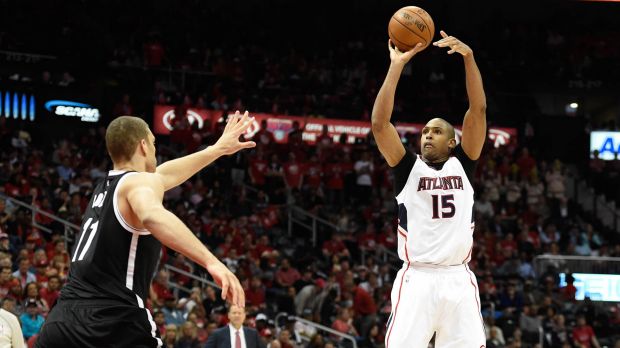The worst shot in basketball is the shot just inside the three-point arc. Everyone knows this. Everyone agrees upon this. A few feet closer to the basket still makes for a relatively long jumper without the additional point. Therefore, a 19-foot jumper at the professional level and a 17-foot jumper at the collegiate level represent mid-range jumpers and very bad shots. There’s very little value in shooting a two-point shot beyond 17 feet in the pros or a 15-footer in college.
Few, if anyone, would disagree.
However, this is where the discussion of the mid-range jumper turns in ways that don’t seem to get enough attention or, for that matter, definitional precision these days.
*
Given that the three-point arc is over 20 feet from the basket in both the college game and the pros (closer to 25 feet than 20 in the NBA), the notion of “mid-range” is — mathematically — inclusive of the 10- to 13-foot range from the basket. This should immediately recast any discussion of mid-range jumpers in terms of the quality of shot they represent, especially in comparison to short shots or threes.
A mid-range jumper at the high or long end of the distance counter, which would be 17 to 19 feet, isn’t a good shot. The 17-footer is a little more allowable in the pros; a 19-footer is hard to justify under any circumstance. However, the low or short end of the mid-range spectrum, which would generally be 10 to 16 feet, is quite necessary for basketball teams to make.
Not convinced of this? Certain that any mid-range shot is worse than a three?
The first round of these NBA playoffs — plus recent playoff history — would indicate otherwise.
How did Chris Paul save the Los Angeles Clippers’ season in the face of elimination — and some weird lineup combinations — during the second half of Game 6 in San Antonio on Thursday night? He wore out the 15-foot elbow jumper from the right side of the court. Paul loaded up on 10- to 16-foot makes to give the Clippers the infusion of offense they so badly needed.
*
On Wednesday night in Atlanta, Al Horford hit multiple 17-footers down the stretch, giving the Hawks crucial baskets in what was essentially (though not technically) a must-win situation against the Brooklyn Nets. Horford’s mid-range shot had been absent for much of the series. Its return could not have been more timely; it is one of a few core reasons Atlanta is not facing elimination on Friday in Brooklyn.
It shouldn’t be hard to see why 10- to 17-foot makes are so important, particularly for a team such as Atlanta. The Hawks need to be able to free up Kyle Korver and DeMarre Carroll when they can for triples, but they also have two speed-demon guards — Jeff Teague and Dennis Schroeder — who need to be able to get open driving lanes to the rim. Having Horford step out and make that 17-footer from the top of the key forces his man to have to leave the restricted area near the basket. The mid-range jumper is an essential source of improved offensive spacing.
Consider also the Chicago Bulls’ just-concluded first-round series against the Milwaukee Bucks. In Game 5, Derrick Rose continued to drive the ball pell-mell to the rim, instead of pulling up for the 12-foot jump shot. Contesting Milwaukee’s length played into the Bucks’ hands and led to a steady parade of very difficult shots. Short-end mid-range jumpers represented the solution the Bulls needed in Game 5.
*
Let’s close this examination with a look at recent NBA history, while also noting how the next round of this year’s playoffs could be shaped by the mid-range jumper.
In the 2012 and 2013 NBA Playoffs, the Miami Heat received vital contributions from Udonis Haslem against the Indiana Pacers. In Game 4 of the 2012 East semifinals — with Indiana leading 2-1 and playing at home — Haslem hit a 16-foot jump shot near the foul line on multiple occasions to give Miami the spacing LeBron James and Dwyane Wade needed to operate more effectively. Haslem’s shooting gave Miami a good-enough replacement for an injured Chris Bosh, a crucial component in the Heat’s title run that spring.
In Game 5 of the 2013 East Finals against the Pacers, Haslem found a different home along the baseline, but he still pumped in a series of 16-foot jumpers to force Indiana’s defense to pay attention to him. This once again spaced the floor for LeBron and Wade. It relieved a lot of Indiana’s defensive pressure from the Heat’s stars. Mid-range makes from Haslem represented a central source of another pivotal playoff victory for Miami.
The 2013 example is certainly worth pointing out, if only for the fact that it affirmed the pattern established in 2012. Yet, it’s the 2012 Heat — without Chris Bosh for almost all of the Indiana series and most of the East Finals against the Boston Celtics — which most closely resemble the LeBron-and-Kyrie Cleveland Cavaliers against the Chicago Bulls in the upcoming East semifinals. Cleveland will need someone — maybe Iman Shumpert — to hit mid-range shots against the Bulls. If they don’t get an added mid-range contributor, the Cavs could find themselves at a deficit.
Bad mid-range shots? Yes, 19-footers in the NBA and 17-footers in college are unnecessary. Lower-end shots in the 10- to 16-foot range? Championships are won because of them.
Plenty of mid-range shots are worth criticizing from the highest hilltop. Many other mid-range shots, on the other hand, are unfairly maligned, and have been for many years.

